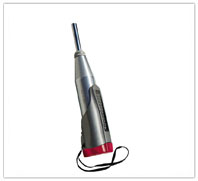The rebound (Schmidt) hammer is one of the oldest and best known methods of comparing the concrete in various parts of a structure and indirectly assessing concrete strength.  The hammer weighs about 1.8 kg and is suitable for use both in a laboratory and in the field. The rebound of an elastic mass depends on the hardness of the surface against which its mass strikes.
The hammer weighs about 1.8 kg and is suitable for use both in a laboratory and in the field. The rebound of an elastic mass depends on the hardness of the surface against which its mass strikes.
Applications
- Finding the elastic properties like compressive strength
- Assessing – the uniformity of concrete.
- Determining variations of strength within a structure
Codes
- IS 13311, IS 516: 1959

- BS EN 12504-2
- ASTM C805
Methodology
- Before commencement of a test, the rebound hammer should be tested against the test anvil, to get reliable results,
- Apply light pressure on the plunger. it will release it from the locked position and allow it to extend to the ready position for the test.
- Press the plunger against the surface of the concrete, keeping the instrument perpendicular to the test surface. Apply a gradual increase in pressure until the hammer impacts
- Take the average of about 15 readings.
Limitations
- Hammer has to be used against a smooth surface, preferably a formed one.
- If the concrete does not form part of a large mass any movement caused by the impact of the hammer will result in a reduction in the rebound number
- Not a very good test for old concrete and low strength concrete.
- Moisture content affects the readings significantly.
- Type of cement also affects the readings.
- Surface Carbonation increases the hammer reading significantly than it actually is.

